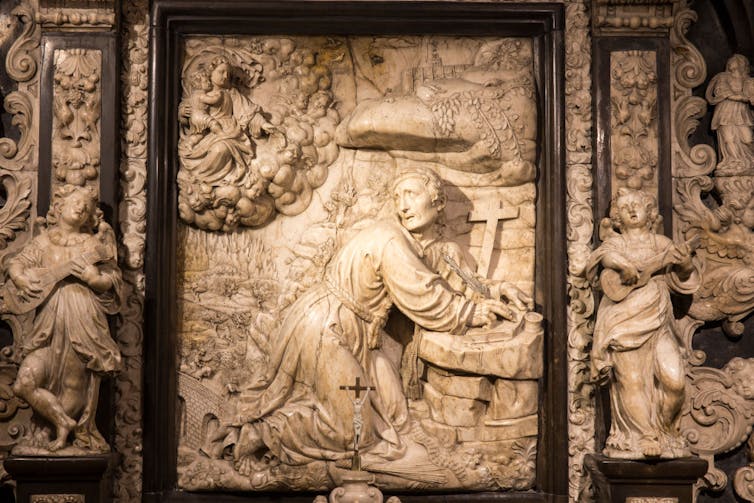Ready to try an old approach to a New Year’s resolution? The story of Saint Ignatius may provide some guidance
- Written by Gordon Rixon, S.J., Associate Professor of Systematic Theology, Regis College, University of Toronto
Making and breaking New Year’s resolutions is a familiar and discouraging annual ritual for many people.
Almost inevitably, in a few short weeks, many find they are unable to meet their goals of self-improvement, be it keeping a positive attitude, improving one’s health[1] or looking for the best in people[2]. Some might even feel diminished as a result of this failure.
The problem, as I see it, is that most people set out with their resolutions often without identifying a practical path for the journey.
As a scholar of systematic theology[3], I believe that Saint Ignatius of Loyola[4], a 16th-century Spanish courtesan, provides insightful guidance. He managed to reverse his life’s direction to pursue a spiritual path.
Who was Ignatius?
Born in 1491, Iñigo, later known as Ignatius[5], was the youngest son of a minor noble family in the Basque region of Spain who left home at the age of 18 to win his place at the royal court.
Over a decade later, as he lay confined to bed recuperating from injuries suffered in the Battle of Pamplona[6] against the French, he daydreamed about potential future exploits at court or service to God and humanity.
It was at that time that he started to notice the subtle development of his feelings. When he dreamed about courtly heroism he later felt depleted, but when he reflected about serving God he felt a deep, lasting and energizing peace.
Reflection about his growing self-awareness led him to make a radical change[7] in the direction of his life. He chose to put aside his quest for glory to serve God and creation, especially his fellow humans, whether friends or strangers.
He met a group of university students who became his companions. In 1540, they together founded the Society of Jesus, commonly known as the Jesuits[8], a community of priests and brothers that became known throughout the world for spiritual development[9], preparatory[10] and university[11] education and justice advocacy[12].
Challenges before Ignatius
This path was not smooth for Ignatius. In the course of his work, he suffered many setbacks, such as suspicion and rejection by church authorities, but he came to a better understanding of himself and his path through those challenges.
As Ignatius narrates in an account of his life[13], which he related just before his death to a fellow Jesuit, the key is not to become suddenly perfect but to learn how to walk patiently and deliberately to grow in love and service despite imperfection.
Ignatius relates his self-driven determination to preach to pilgrims in Jerusalem. His intention, however, was not well received by church authorities, who thought he was poorly prepared. This rejection led him to further his education and become more flexible about how he understood his role in serving God.
He writes about how he was easily provoked to self-righteous anger. Once he took offense when a fellow traveler made an insulting comment about the Virgin Mary. Only the stubborn donkey he was riding[14] saved him from pursuing the other traveler and acting on a murderous rage.
[Get the best of The Conversation, every weekend. Sign up for our weekly newsletter[15].]
In the sharing of his story, Ignatius does not want his biography to become the center of attention. He provides an example of moving beyond the isolated facts of his life journey to reflect about their interconnected meaning and a way of looking beyond.
As the scholar of renaissance rhetoric Marjorie O'Rourke Boyle[16] suggests, Ignatius is using the story about himself to redirect his readers’ attention to God and a higher purpose[17]. Unflinching about relating his own faults, Ignatius encourages individuals to reflect on their desires, resources and vulnerabilities as a way to grow.
Practical guidance from Ignatius
 The cave in Manresa, Spain where Saint Ignatius is said to have prayed from March 1522 to February 1523 and wrote his spiritual exercises.
Christian Ender / Contributor/Getty Images News[18]
The cave in Manresa, Spain where Saint Ignatius is said to have prayed from March 1522 to February 1523 and wrote his spiritual exercises.
Christian Ender / Contributor/Getty Images News[18]
In the “Spiritual Exercises[19],” his manual for prayer guides, Ignatius suggests a five-step daily process, known as the “Examen[20],” as a way to tell and retell life-transforming stories. These, I believe, are practical recommendations that could help people realize their resolutions in the New Year.
Start with a realistic, accurate and encouraging assessment of your current situation. Ignatius would always begin his moments of reflective self-assessment by reaffirming his gratitude for life and opportunities to serve in a project larger than himself[21]. Acknowledge strengths, vulnerabilities, positive and negative feelings, and areas of encouragement and discouragement as gifts.
Be open to the light of a larger perspective. Call upon the assistance of a higher power to reveal the big picture that holds together the pieces of the journey through the day. Expect to be surprised by new insights.
Focus on the events of today. Create a story that links the episodes of the day and your goals together. Ignatius would move beyond just listing strengths, weakness and feelings to discover how they advanced or impeded his goal to serve God and others[22].
Identify the moments of darkness and discouragement that resist being drawn into your story. Ask what episodes disrupt your understanding of yourself and the world. Find new perspective by deepening your commitment to a higher purpose.
Much like the beliefs in other religions, Ignatius turns to his faith to find a new perspective during difficult moments. Christianity and other religious traditions[23] such as Buddhism, Confucianism, Hinduism, Islam and Judaism help find purpose in a compassionate and merciful love that inspires and guides day-to-day actions, each in their own way.
As a Christian, Ignatius looked especially to the example of compassionate self-sacrifice in Jesus’ death on the Cross to hold difficult moments in a higher faith perspective. By committing to accept the cost of positive action in the face of his own failings or opposition by others, Ignatius was able to move through obstacles and find encouragement and strength to advance his story[24].
Finally, reflect on how your story offers direction and energy to move forward to the next day. By incorporating discouraging moments into the flow of a larger story, Ignatius learned how to move beyond the shame and confusion[25] caused by failure and misdeeds to a healthy sense of sorrow. It helped Ignatius find a higher purpose.
Like Ignatius, many of us may need to revise our resolutions and reflect on how we may proceed, even when we feel discouraged.

References
- ^ improving one’s health (www.nbcnews.com)
- ^ looking for the best in people (www.theatlantic.com)
- ^ scholar of systematic theology (regiscollege.ca)
- ^ Saint Ignatius of Loyola (www.ignatianspirituality.com)
- ^ Ignatius (www.luc.edu)
- ^ Battle of Pamplona (www.history.com)
- ^ radical change (ignatiancamino.com)
- ^ Jesuits (www.jesuits.org)
- ^ spiritual development (www.jesuits.global)
- ^ preparatory (www.sjweb.info)
- ^ university (iaju.org)
- ^ justice advocacy (www.jesuits.org)
- ^ account of his life (jesuitsources.bc.edu)
- ^ stubborn donkey he was riding (www.ignatianspirituality.com)
- ^ Sign up for our weekly newsletter (theconversation.com)
- ^ Marjorie O'Rourke Boyle (www.religion-online.org)
- ^ redirect his readers’ attention to God and a higher purpose (www.ucpress.edu)
- ^ Christian Ender / Contributor/Getty Images News (www.theatlantic.com)
- ^ Spiritual Exercises (www.ignatianspirituality.com)
- ^ Examen (www.ignatianspirituality.com)
- ^ project larger than himself (www.vatican.va)
- ^ his goal to serve God and others (store.loyolapress.com)
- ^ religious traditions (www.orbisbooks.com)
- ^ advance his story (store.loyolapress.com)
- ^ shame and confusion (orthodoxyindialogue.com)
Authors: Gordon Rixon, S.J., Associate Professor of Systematic Theology, Regis College, University of Toronto

